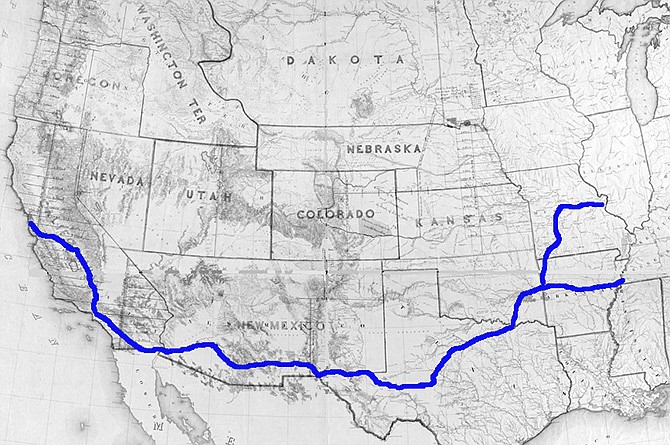TIPTON, Mo. - When John Butterfield stepped off the Pacific Railroad at the end of the line west in Tipton on Sept. 16, 1858, he then embarked on the historic, first overland mail route.
The long-requested, but short-lived Butterfield Overland Mail Route shortened U.S. postal service from five months aboard a ship traveling around Cape Horn to 25 days by land.
The National Park Service (NPS) is in the process of considering the route as a new national trail. If confirmed, it would join five of the current nine trails managed by the National Trails Intermountain Region in Missouri - California, Oregon, Santa Fe, Pony Express and Trail of Tears.
"Missouri does have the greatest number of trail entities than any other state," said NPS historian Frank Norris. "No other state has more than four NHTs - and as a bonus, Missouri has a good chunk of Route 66 as well."
The Omnibus Public Land Management Act of 2009 authorized a study to assess if the route qualified under the National Trails System Act of 1968.
A 40-page significance statement is available at the National Park Service website.
Norris' office will complete a draft version of the special resource study by early spring, after which there will a public comment period.
Park service researchers concluded the Butterfield route was nationally significant for expressing cultural values in literature, mass media and popular culture; for representing an ideal of the American people, for developing the American economy and for contributing to broad patterns in the nation's history, the NPS significance statement said.
"Although the Overland Mail Company operated along the so-called "southern route' for only two and one-half years, the fact that it was the first "transcontinental' stage route resonated with Americans," the statement said. "The implementation of the Butterfield route brought the disparate parts of the country together by providing twice weekly stages."
The first U.S. Mail traveled to California by steamship, through the Isthmus of Panama in 1848. The ocean route remained a vital link in the nation's mail system until the completion of the transcontinental railroad in 1869, according to the U.S. Postal Service website.
The Butterfield Overland Mail Route to San Francisco was the fastest letter-carrying option for only a few months, when in April 1860, the Central Overland California and Pike's Peak Express Company opened the Pony Express from St. Joseph to Sacramento, California. The transcontinental telegraph construction followed in October 1861.
The Butterfield proposal, following what was called the Oxbow route, was selected from among nine proposals and four potential routes in 1857. The 2,700-mile route passed through Missouri, Tennessee, Arkansas, Oklahoma, Texas, New Mexico, Arizona and California.
Born in New York in 1801, Butterfield had been working around stagecoaches since age 10 and driving by age 19. By age 30, he owned his own stage company.
His firm merged with two others, owned by Henry Wells and William Fargo, in 1850 to form the American Express Company.
At one time, Butterfield had 1,500 horses and mules, 100 coaches, 160 relay stations about 20 miles apart and 2,000 employees along the trail, according to the State Historical Society of Missouri's roadside marker.
Each driver had a 60-mile route and return, among the 139 relay stations and forts. A through passenger ticket was $200.
"As any passenger could attest, comfort was not particularly valued on Butterfield coaches," the statement said. "Because there was often a waiting list for the available seats, the company ... thought nothing of packing its Concord coaches."
Although the Missouri miles were fairly manageable, overland routes were an ordeal, with threat of disease, Native American attacks and accidents.
The first 160 miles west of the Mississippi River were by rail.
"John Butterfield and his associates knew that there was no particular reason to have a stagecoach line west from St. Louis, because it would be a lot easier for the mail sacks to ride via the railroad west to Tipton before being transferred to a stagecoach," Norris said. "As a result, Tipton is the true beginning of the Butterfield Route."
From Tipton to Springfield, following the Bolivar Road also called the Old Boonville Mail Road, they used a wooden-roofed Concord, or southern-style, coach pulled by six horses. Less than a year later, Pacific Railroad extended its tracks another six miles west and Syracuse became the new transfer point from rail to stage.
The Missouri coach would meet up with a southern route stage from Memphis, Tennessee, at Fort Smith, Arkansas. From there, they used mules or canvas-topped Celerity wagons, depending on terrain.
No newspapers announced the Butterfield Overland Mail Company's first departure from St. Louis Sept. 16, 1858. Butterfield himself escorted two, small leather pouches from the post office to the train station and then aboard the train.
A few villagers in Tipton turned out for the train's arrival. Tipton was laid out by William Tipton Seeley in 1858, shortly before it became the Butterfield eastern terminus, according to the State Historical Society of Missouri's roadside marker.
Butterfield transferred the mail pouches to the waiting stagecoach, driven by his son ,John Butterfield Jr.
Link:

